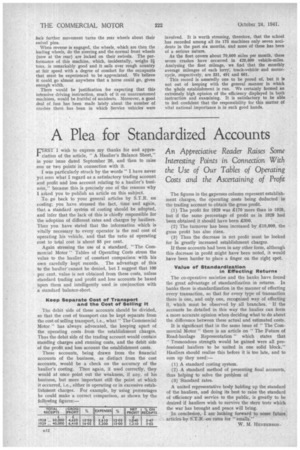A Plea for Standardized Accounts
Page 30

If you've noticed an error in this article please click here to report it so we can fix it.
rIRST I wish to express my thanks for and appreciation of the article, " A Haulier's Balance Sheet," in your issue dated September 26, and then to raise one or two points in connection with it.
I was particularly struck by the words " I have never yet seen what I regard as a satisfactory trading account and profit and loss account relating to a haulier's business," because this is precisely one of the reasons why I asked you topublish an article on this subject.
To go back to your general articles by S.T.R. on costing; you have stressed the fact, time and again, that a standard system of costing should be adopted, and infer that the lack of this is chiefly responsible for the adoption of different' rates and charges by hauliers. Then you have stated that the information which is vitally necessary to every operator is the real cost of operating his vehicle, and that the ratio of operating cost to total cost is about 85 per cent.
Again stressing the use of a standard, "The Commercial Motor " Tables of Operating Costs stress the value to the haulier of constant comparison with his own carefully kept records. The advantage of this to the haulier cannot be denied, but I suggest that 100 per cent. value is not obtained from these costs, unless standard trading and profit and loss accounts be based upon them and intelligently used in conjunction with a standard balance-sheet.
Keep Separate Cost of Transport and the Cost of Selling It
The debit side of these accounts should be divided, so that the cost of transport can be kept separate from the cost of selling transport, i.e., what " The Commercial Motor" has always advocated, the keeping apart of the operating costs from the establishment charges. Thus the debit side of the trading account would contain standing charges and running costs, and the debit side of the profit and loss account the establishment costs.
These accounts, being drawn from the financial accounts of the business, as distinct from the cost accounts, would be a check on the accuracy of the haulier's costing. Then again, if used correctly, they would at once point out the weakness, if any, of his business, but more important still the point at which it occurred, i.e., either in operating or in excessive establishment charges. For example, by using percentages he could make a correct comparison, as shown by the following figures:—
The figures in the expenses column represent establishment charges, the operating costs being deducted in the trading account to obtain the gross profit.
(1) The profit for 1929 was :£170 more than in 1928, but if the same percentage of profit as in 1928 had been obtained it should have been £350.
(2) The turnover has been increased by £10,000, the gross profit has also risen.
(3) Thus the decrease in net profit must be looked for in greatly increased establishment charges.
If these accounts had been in any other form, although this decrease in profit might have been noted, it would have been harder to place a finger on the right spot.
Value of Standardization in Effecting Returns
The co-operative societies and the banks have found the great advantage of standardization in returns. In banks there is standardization in the manner of effecting every transaction, so that for every type of transaction there is one, and only one, recognized way of effecting it, which must be observed by all branches. • If the accounts be detailed in this way the haulier can form a more accurate opinion when deciding what to do about the difference between these actual and estimated costs.
It is significant that in the same issue of " The Commercial Motor " there is an article on " The Future of Road-haulage Representation " which states that " Tremendous strength would be gained were all professional hauliers to be united in one solid block." Hauliers should realize this before it is too late, and to sum up they need:—
(1) A standard costing system.
(2) .A standard method of presenting final accounts, thus helping to solve the problem of (3) Standard rates.
A united representative body holding up the standard of the hauliers, and doing its best to raise the standard of efficiency and service to the public, is greatly to be desired if hauliers wish to survive the stern tests which the war has brought and peace will bring.
In conclusion, I am looking forward to some future articles by STT.R. on rates for " smalls."




















































